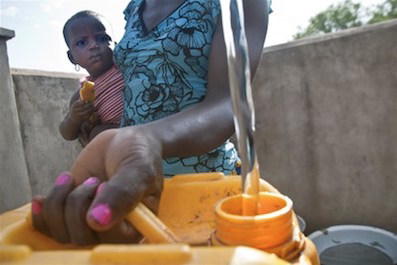 Cleanzine: your weekly cleaning and hygiene industry newsletter 10th July 2025 Issue no. 1170
Cleanzine: your weekly cleaning and hygiene industry newsletter 10th July 2025 Issue no. 1170
Your industry news - first
The original and best - for over 20 years!
We strongly recommend viewing Cleanzine full size in your web browser. Click our masthead above to visit our website version.
Climate change and lack of sanitation threaten water safety for millions: UNICEF
 On Tuesday - World Water Day, UNICEF said the push to bring safe water to millions around the world is going to be even more challenging due to climate change, which threatens both water supply and water safety for millions of children living in drought- or flood-prone areas.
On Tuesday - World Water Day, UNICEF said the push to bring safe water to millions around the world is going to be even more challenging due to climate change, which threatens both water supply and water safety for millions of children living in drought- or flood-prone areas.
In 2015 at the end of the Millennium Development Goal era, all but 663 million people around the world had drinking water from improved sources - which are supposed to separate water from contact with excreta.
However, data from newly available testing technology show that an estimated 1.8 billion people may be drinking water contaminated by e-coli - meaning there is faecal material in their water, even from some improved sources.
"Now that we can test water more cheaply and efficiently than we were able to do when the MDGs were set, we are coming to terms with the magnitude of the challenge facing the world when it comes to clean water," said Sanjay Wijeserkera, head of UNICEF's global water, sanitation and hygiene programmes. "With the new Sustainable Development Goals calling for 'safe' water for everyone, we're not starting from where the MDGs left off; it is a whole new ball game."
One of the principal contributors to faecal contamination of water is poor sanitation. Globally 2.4 billion people lack proper toilets and just under one billion of them defecate in the open. This means faeces can be so pervasive in many countries and communities that even some improved water sources become contaminated.
When water becomes scarce during droughts, populations resort to unsafe surface water. At the other end of the scale, floods damage water and sewage treatment facilities, and spread faeces around, very often leading to an increase in waterborne diseases such as cholera and diarrhoea.
Higher temperatures brought on by climate change are also set to increase the incidence of water-linked diseases like malaria, dengue - and now Zika - as mosquito populations rise and their geographic reach expands.
"Climate change is one of the greatest threats of our time, whose impact is being felt more acutely around the world," says David Morley, President and CEO of UNICEF Canada. "Children and young people are especially vulnerable to its destabilising impact."
According to UNICEF, most vulnerable are the nearly 160 million children under five years old globally who live in areas at high risk of drought. Around half a billion live in flood zones. Most of them live in sub-Saharan Africa and in Asia.
UNICEF is responding to the challenges of climate change by focusing on disaster risk reduction for water supplies. For example:
Nearly 20,000 children in Bangladesh now have access to climate and disaster-resilient sources of water through an aquifer-recharge system which captures water during the monsoon season, purifies it, and stores it underground.
In Madagascar, UNICEF is helping local authorities make classrooms for 80,000 children cyclone- and flood-proof, and provide access to disaster-resilient sources of water.
In drought-prone Kiribati, new rainwater-harvesting and storage facilities are improving communities' access to safe drinking water.
Last year, the Government of Canada committed $2.65 billion to take action on climate change. Canada is also providing humanitarian assistance funding to address climate related humanitarian emergencies. This includes a $4 million contribution to support UNICEF's efforts in Ethiopia to help improve access to safe water and sanitation for drought affected households, and protect children who face increased vulnerability due to drought.
"We are in a race against time to stop a bad situation from becoming worse," says David Morley. "We're pleased by the Government's efforts to lead the charge against climate change, and encourage Canada to continue to support investments that prioritise children and young people, and strengthen the resilience of the poorest and most vulnerable."
In a recent publication, Unless We Act Now, UNICEF set out a 10-point climate agenda for children. It sets out concrete steps for governments, the private sector and ordinary people to take in order to safeguard children's futures and their rights.
Starting on World Water Day and ending with the signing of the Paris Agreement on 22nd April, UNICEF launched a global Instagram campaign to raise awareness of the link between water, the environment, and climate change.
Using the #ClimateChain hashtag, UNICEF Executive Director Anthony Lake, UN General Assembly President Mogens Lykketoft, UN climate chief Christiana Figueres, and other prominent figures will figuratively join hands with members of the public in a chain of photographs intended to urge action to address climate change. The images will be presented at the signing of the Paris Agreement.
A woman with a toddler fills a jerrycan at a community water point in Ou�r�gu�kaha Village in C�te d'Ivoire. After four years, households again have access to safe, piped water, thanks to a UNICEF programme.
24th March 2016







